Sustainability Action Plan Takes Shape
Ann Arbor planning commission and energy commission joint working session (April 8, 2014): Continuing a process that began more than four years ago, members of the city’s planning and energy commissions received an overview of the draft sustainability action plan and gave feedback toward finalizing the document.
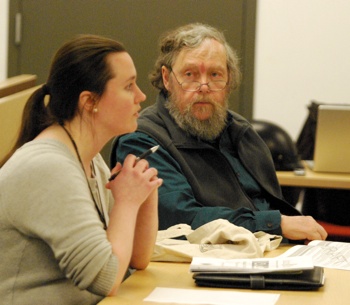
Jamie Kidwell, the city’s sustainability associate, and Wayne Appleyard, chair of the Ann Arbor energy commission. (Photos by the writer.)
The action plan identifies steps to implement 16 broad goals in a sustainability framework that was added to the city’s master plan last year. The goals are organized into four categories – resource management; land use and access; climate and energy; and community – that were culled from existing city plans and reorganized into this new framework.
The intent is to track efforts toward achieving the 16 goals, which cover a wide range of issues – from increasing renewable energy use and developing a resilient local economy to eliminating pollutants and maintaining Ann Arbor’s unique sense of place. The action plan includes specific indicators that measure progress in each area.
Jamie Kidwell, the city’s sustainability associate, is taking the lead on this project, and fielded questions from commissioners. Part of the goal is for each of the city’s commissions to incorporate these sustainability efforts into their own work plans, she noted. But the action plan is primarily to guide staff efforts. The action plan is also coordinated with the city’s budget process, tying in to the city council’s budget priorities.
Commissioners expressed interest in more collaboration – both among the city’s various commissions, and with other jurisdictions. One start will be to share their work plans, though not all commissions have those.
Commissioners also discussed the idea of holding an annual joint meeting of multiple commissions, possibly in September. Planning manager Wendy Rampson noted that the kick-off for developing the sustainability framework had begun with a joint meeting – with the planning, energy and environmental commissions – in April 2010.
Sustainability Action Plan: Overview
Jamie Kidwell, the city’s sustainability associate, began her briefing by explaining how the action plan is tied to the city’s sustainability framework. Each of the framework’s 16 broad goals is tied to targets for achieving that goal, and concrete actions to hit those targets. “The intent of this document is to really help measure our progress towards our sustainability goals, and to really ground those big, lofty goals … to some of these more measurable actions.” [.pdf of draft sustainability action plan]
The action plan will be a living document, Kidwell said. Some new indicators are included in the plan, she noted. It will be a learning process for staff, and some of the indicators will work better than others, Kidwell said. That means there will be adjustments in the future.
Because the document is primarily for staff, Kidwell said, there have been conversations among staff about how the goals, targets and actions are already being worked on in the short term. The plan isn’t meant to be all-inclusive, she noted, so not everything that staff are working on will be included. She stressed that it’s not really a new plan, but rather a reorganization of some efforts that are already underway.
One key component of the action plan is that it brings in budget goals that are set by staff each year during the budget cycle. The benefit of that approach is that it allows staff to work with an existing mechanism, Kidwell said, capitalizing on the budget process to more clearly communicate the sustainability goals to other staff, city advisory commissions, the city council and the public.
For example, this year the planning unit’s budget goals are explicitly tied to sustainability goals, Kidwell noted. [Responding to a follow-up query from The Chronicle, Rampson stated that the budget goals are still in draft form and are being reviewed by the city administrator. They will become available to the public as part of the budget book when it is presented to the city council in late April or early May.]
The draft action plan also includes a chart that identifies which unit within the city will be responsible for each of the sustainability goals. For example, the sustainability goals for local food are the primary responsibility of the parks and recreation unit, which includes the farmers market and greenbelt program. Kidwell noted that this chart might change, based on feedback from staff.
Kidwell said she wanted to talk to the city’s advisory commissions about the action plan in part because there’s opportunity to help both staff and the commissions find areas that are of common interest. Most commissions develop a work plan for each fiscal year, she noted. How do those work plans feed into the sustainability process?
The intent is to update the action plan every two years, Kidwell said. She asked commissioners for feedback about whether they thought the document would be useful to them, and if it helped communicate the city’s targets and actions regarding sustainability. “Does it really help you get your arms around what city staff is working on, in terms of our sustainability goals?” she asked.
Wendy Rampson, the city’s planning manager, reported that she’d reviewed the action plan with planning commission chair Kirk Westphal and Ken Clein, the commission’s secretary. They’d compared it to the planning commission’s work plan, and had found that there was alignment. [The planning commission most recently reviewed its work plan in detail at a Jan. 7, 2014 working session. See Chronicle coverage: "Planning Commission Reviews 2014 Priorities."]
Sustainability Action Plan: Commission Discussion
Chuck Hookham of the energy commission reported that he’s involved with several national programs on sustainability and infrastructure, and he gives presentations on these topics. When talking to the public, one of the main questions that’s asked is “What are we getting out of this?” he said. If taxpayer money is being spent, where’s the return on investment? As professionals, he said, they need to be better at communicating that.
Hookham speculated that if he were to ask people in the community to define sustainability, he’d probably get a hundred different answers. So the city needs to be more specific about its goals. “I think that’s how we’ll get to the end game, which is improving life in the future,” he said.
In terms of communicating with the public, Jamie Kidwell said the city plans to have a very robust online version of this action plan. Part of that includes transitioning the current State of Our Environment report to a State of Our Sustainability report, she said. The idea is to provide snapshots online of city projects, and a report of indicators in the action plan, so that the community has concrete evidence that the city is working toward these goals.
Mark Clevey, an energy commission member, wondered how specific the indicators will be. For example, for the indicator of renewable electricity generation, will it be broken down into the number of solar energy systems, or how much renewable power is purchased from utilities?
Kidwell said the level of specificity is still under discussion. The State of the Environment report has 60 indicators that include a very deep level of detail, she noted. “We might be taking a fresh look at how we tell that story.” She encouraged commissioners to give feedback.
Clevey told Kidwell that “more is better” in terms of detail. Wendy Rampson, the city’s planning manager, noted that the time that staff spends entering data is time that they won’t have to do other things. The city can use interns for some of that work, she said, but “we’re trying to balance what gives people a sense of information, without being a slave to updating the data constantly.”
Rampson said if commissioners know of websites that they think would be effective models for presenting this information, they should let Kidwell know. Hookham cited the Envision sustainable infrastructure rating system, created by the Institute for Sustainable Infrastructure. He described it as a program that’s similar to LEED, except that it deals with non-building facilities.

From left: Sabra Briere and Bonnie Bona of the planning commission. Briere also serves on the city council.
Bonnie Bona of the planning commission asked how the staff was dealing with creating indicators for targets that aren’t numerical. For example, the “engaged community” goal has this target: “Increase effectiveness of communication and service delivery.” How do you quantify that? she asked.
Kidwell noted that there are several areas – including community services, human services, and economic development – that are much harder to quantify. “I think we’re going to have to grow into some of these,” she said. One way to help make some of the indicators “less squishy,” Kidwell said, is to look at the targets and actions, and ask: What will these do, and what indicator follows from that?
Kidwell gave an example by looking at a human services goal: “Provide services that meet basic human needs of impoverished and disenfranchised residents to maximize the health and well-being of the community.” A target to achieve that goal is: “Increase housing stability of public housing residents.”
Within that target, several actions are identified:
- Create a Family Self Sufficiency Program for public housing and voucher residents to increase financial self-sufficiency.
- Increase employment of low-income households on housing commission projects.
- Create permanent supportive housing site with 24-hour front desk security.
- Increase supportive services to public housing units, including food, mental health, case management, and financial literacy.
For these actions, staff have identified the following indicators: (1) number of case managers for public housing sites; (2) percent of public housing residents employed; (3) percent of public housing units with supportive services; and (4) coordinated funding impact(s).
The idea is to find correlations between the indicators and targets/actions, Kidwell said. It’s more difficult for some of the goals, and the staff will be looking for feedback on whether they’ve identified the best indictors – especially as they start tracking the results, she said. “I think it’s going to be a learning process.”

The April 8 working session was the last meeting that Dina Kurz will attend as a member of the Ann Arbor energy commission. Her term ends on April 18, 2014 and she is not seeking reappointment. She was first appointed in April 2008.
Bona encouraged staff and commissions to think of these indicators in terms of “how they help us get the work done.” Then the indicators become something that’s needed, she said, rather than just a tracking of what has occurred.
Kidwell pointed out that the plan tries to capitalize on items that are already being tracked. That’s one reason why it’s being tied to the budget process. The staff goes through a process of identifying targets within each budget cycle, including what they hope to achieve during the fiscal year. As these things get pulled into the sustainability action plan, she said, the plan will evolve.
Kirk Westphal, chair of the planning commission, asked if it would be helpful for a smaller committee – with members from various commissions – to work on goals from the sustainability plan. Kidwell hoped that the action plan would help commissioners identify ways to work together. As an example, several different commissions have talked about incentives for sustainable “green” buildings. Westphal said he could envision how a committee with members from the planning, energy and environmental commissions could “really button down what the metrics are” for achieving that goal.
Mike Shriberg of the energy commission asked Kidwell to talk more about the intersection of the budget with the action plan. Kidwell replied that as part of the budget process, city staff are asked to identify what they’ll be working on in the short term, what they expect to achieve, and the metric for assessing their work. The hope is to coordinate that work with the sustainability action plan.
Rampson told commissioners that every city administrator has a different take on how they want the staff to develop the budget. City administrator Steve Powers, who started with the city in the latter part of 2011, has been working with the city council to identify budget priorities. Those priorities include fiscal discipline, public safety, infrastructure, economic health, affordable housing, and quality of life. Powers is trying to get the city staff to think about how their work fits within those priorities, Rampson said.
Rampson noted that she, Kidwell and other staff are advocating to incorporate the sustainability framework into this process as well, to see how work on a day-to-day basis fits within that framework. The planning commission’s work program fit really nicely, she said. For example, the planning commission’s work on downtown zoning – a project that the council had asked the commission to undertake – fits within the sustainability action plan under the category of integrated land use and following goal: “Encourage a compact pattern of diverse development that maintains our unique sense of place, preserves our natural systems, and strengthens our neighborhoods, corridors, and downtown.”
Within that goal, one of the targets states: “Encourage dense land use and development patterns which draw people downtown and foster an active street life, contribute to its function as an urban residential neighborhood and support a sustainable transportation system.” An action item to achieve that target is to implement the rezoning and code amendment recommendations of the downtown zoning evaluation. That’s part of the planning commission’s work program for this year, Rampson said.
“In the ideal world,” Rampson said, “you have that line-of-sight from what you’re doing on a day-to-day basis all the way through to the sustainability goal and on to council’s budget priorities.”
Kidwell said the draft action plan reorganizes some of the current budget goals from various city units, slotting them into sustainability goals. Going forward, the hope is that each unit, as they set budget goals, will have the sustainability plan in mind. That will make it easier to pull the budget goals into the plan, she said.
Sabra Briere, who serves as the city council representative on the planning commission, said the council will benefit from seeing the direction that everyone is heading. It’s really easy for councilmembers to lose sight of what’s happening in the whole organization, “because you’re dealing only with what’s right in front of you,” she said. The sustainability action plan is a working document that will help councilmembers see how the priorities they set in December are being implemented for the budget process in May, Briere said. [The city's fiscal year runs from July 1 through June 30. The budget is adopted no later than May for the coming fiscal year.]
Bona noted that the budget isn’t the only document that drives investments. The capital improvements plan (CIP) also addresses the city’s investments in infrastructure and assets. There’s a sophisticated matrix for developing priorities in the CIP, she said. But that matrix looks at “the act of building, not the use,” Bona said. [.pdf of CIP prioritization matrix]
Kidwell replied that the sustainability goals are already part of the CIP prioritization process. Projects get points in the prioritization ranking if they further one or more of the sustainability goals. That’s not the perfect approach, she added, but it’s a start. Kidwell said she’s already had some conversations with Deb Gosselin, who oversees the CIP process, about whether changes should be made to the matrix in the upcoming CIP cycle. Again, it’s a learning process, Kidwell said.
Energy commissioner Shoshannah Lenski praised the action plan. She suggested including some very broad indicator, possibly by category, that signals how much progress is being made. It might simply be a green, yellow or red circle next to each target, for example. It could be a qualitative assessment by staff, she said, about whether they think they’re on track with the targets.
Kidwell joked that there’s a blank page in the draft document titled “Plan Progress.” It’s blank because the staff are working on how to best represent the data. She noted that the State of Our Environment report uses green, yellow or red colors to indicate good, fair or poor progress toward the goals, and arrows to indicate whether the indicators are moving in the desired direction.
Dina Kurz of the energy commission asked about incorporating “the language of resilience.” Resilience is an important vocabulary word, she noted, adding that it would fit into one of the targets for a safe community: “Adapt to and effectively manage current hazards and emerging threats from climate impacts.” The word could even be included in targets for public health and disaster preparedness. “What we’re hoping for is that the community remains resilient,” Kurz said.
Kurz thought it would be an important descriptive term. The concept of resilience would be complicated to use as a measure, but it could be an umbrella measure for a lot of different goals. The energy commission, for example, has talked about the benefit of the city’s hydroelectric dam that produces electricity, she said. Local electrical production is a valuable resource, she noted, and there might be other opportunities along the Huron River to produce electricity. That’s a measure of resilience.
The category of local food is another good fit for resilience, Kurz said. Having local food production and promoting that – through farmers markets, for example – is a way to provide resilience if there are disruptions in transportation from outside sources. All of these things interweave, she noted. Local food and markets, she said, also provide a center for community and neighborhood development.
Noting that this was her last meeting as an energy commissioner, Kurz encouraged other commissioners and staff to continue working hard to understand what’s going on in various parts of the community, and to bring those things together “under one tent.”
Brigit Macomber reported that the energy commission is starting to look at the issue of “time of marketing,” which she said seems to dovetail with green housing. That seems like a topic that lends itself to working with other commissions, she said. How could they make that happen?
Wayne Appleyard, chair of the energy commission, explained that this concept would require a homeowner to disclose energy usage when selling a house, and it might include an energy audit. The “time of marketing” refers to the fact that the disclosure would occur when a property is marketed, as opposed to the “time of sale.” It would allow a homebuyer to make a more informed choice, he said, and it could allow them to secure a mortgage that might include funding for energy efficiency improvements.
Kidwell noted that the action plan includes targets for energy efficiency. Responding to Macomber’s query about collaboration among commissions, Kidwell said the best way to involve multiple commissions on a topic would be to talk to the staff who support the commissions’ work.
Rampson said the key is to find the best fit for overlapping issues. The planning commission isn’t involved directly when single-family residential properties are sold. It might be a better fit for planning commissioners to work with the energy commission on the commercial energy disclosure project, she said, as part of the site plan review that the planning commission undertakes. Even when something isn’t required by city code, Rampson said, the planning commission can introduce the concept to people as they come through the site plan review process.
Macomber explained that she’d been asking a process question. There are rules about how many people can meet, and at what point it becomes a public meeting, she noted – referring to requirements of the Michigan Open Meetings Act. It would be helpful to get staff direction about how to approach joint commission work. “I think it’s great to have the commissions working together. I see a lot of potential in that,” she said.
As a starting point, Kidwell suggested that each commission could begin sharing their work plans with other commissions, and flag a few areas where there might be mutual interest. Westphal asked if each commission’s work plan is posted. It varies, Kidwell said. Westphal suggested emailing work plans for each commission to members of all the commissions.
Briere highlighted topics she’d like to discuss with the energy commission, such as solar shading. She indicated that she wasn’t sure of the mechanism for holding such discussions. She’s also interested in the fact that if you invest in a solar roof, the assessment of your property increases. “So not only do you not get a tax break anymore, but you get a penalty,” she said. As the city promotes installing solar roofs, how do they deal with that?
Appleyard replied that the city council, on which Briere serves, probably has the ability to create a policy. He reported that when energy commissioners met with the city assessor, the assessor had said he’d been told by state officials “that he had the ability to interpret things,” Appleyard said.
David Wright of the energy commission said his understanding is that the city has some discretion regarding assessments, “and we need to further understand what that discretion exists.” Is it with the state tax commission? Or is there some discretion that falls to the city?
Briere said the council has been told that they can’t set policy related to assessments, so she was trying to figure out what can be done in other ways. Wright replied: “We want to help figure that out.”
Appleyard noted that recently, three commissions – planning, energy and environmental – had passed similar resolutions recommending to council that sufficient staff be hired to implement the city’s climate action plan. “I think there was some real power in having more than one commission pass resolutions,” he said, “so I think we need to make use of that, when possible.”
Macomber asked if commissioners would be having regular joint sessions. Kidwell said it’s up to commissioners, and noted that the precedent is there. If there’s interest from multiple commissions, the staff can figure out how to schedule it.
Shriberg noted that the sustainability plan is a great forum for bringing commissions together, because the plan’s indicators touch on the interests of many commissions. Kidwell suggested an annual meeting to talk about progress toward the plan’s goals. Commissions could also present their work plans to each other at that time.
Planning commissioner Jeremy Peters said that one of the planning commission’s jobs is to look far into the future. Having a process like the one Kidwell described would help with that.
Ken Clein of the planning commission wondered if there’d been any thought to coordinating with Washtenaw County government as well. It’s important to realize that Ann Arbor doesn’t exist in a vacuum. Kidwell said staff had struggled with that question in developing the sustainability plan. As a starting point, the plan makes the city’s work more transparent, she noted. Another step would be incorporating partners, she said – for example, she’s already been talking with the county’s office of community & economic development about their work.
Kidwell reported that she’s working on a countywide housing project, too – that’s just one example of work that’s being done with other partners, she said.
Briere gave several examples of areas where there are commissions in multiple jurisdictions that do similar work – Ann Arbor has a park advisory commission, and Washtenaw County has a parks & recreation commission. Many jurisdictions have housing-related commissions. She said she didn’t know all of the commissions that existed countywide. She wondered if the staff saw any opportunity to bring together commissions outside of Ann Arbor with Ann Arbor commissions, “to really talk through the next set of ideas, whatever they may be.” It would be great to see regional planning, Briere said.
Kidwell agreed that it’s something to support. She gave the example of the Reimagine Washtenaw project, which involved several jurisdictions – Ann Arbor, Ypsilanti, Ypsilanti Township and Pittsfield Township – to improve the Washtenaw Avenue corridor between Ann Arbor and Ypsilanti.
Rampson noted that the Reimagine Washtenaw project is at a critical point, because the federal grant that’s paid for staff is ending in the next year. Now, each community must decide whether it wants to continue paying for that staff work, she said. The challenge is how to keep a project like this moving ahead.
There’s benefit in not reinventing the wheel, Rampson said – that’s a reason to collaborate with other communities.
Commissioners wrapped up by discussing the timing of an annual meeting of multiple commissions, possibly in September. Rampson noted that the kick-off for developing the sustainability framework had begun with a joint meeting – between the planning, energy and environmental commissions – in April 2010. [See Chronicle coverage: "Building a Sustainable Ann Arbor."]
Rampson suggested that the chairs of these three commission meet to do some planning, and to include the housing and human services advisory board too, and possibly the park advisory commission. Another possibility is to create a committee focused on the CIP.
As a follow-up to sharing work plans, Kurz asked that the planning commission’s work plan be shared with other commissions, so that it could be used as a template. [.pdf of planning commission's work plan] The environmental commission also has an active work plan, which was adopted in September 2013. [.pdf of environmental commission's work plan] The energy commission doesn’t have a current work plan. Nor does the housing & human services advisory commission, but Briere indicated that she would bring up the issue at the HHSAB’s next meeting.
Planning commissioners present: Bonnie Bona, Sabra Briere, Ken Clein, Diane Giannola, Paras Parekh, Jeremy Peters, Kirk Westphal.
Energy commissioners present: Wayne Appleyard, Mark Clevey, Erik Eibert, Chuck Hookham, Dina Kurz, Shoshannah Lenski, Brigit Macomber, Mike Shriberg, Ken Wadland, David Wright.
Staff present: Planning manager Wendy Rampson; Nate Geisler, energy programs analyst; Jamie Kidwell, sustainability associate.
Next planning commission meeting: Tuesday, April 15, 2014 at 7 p.m. in the second floor council chambers at city hall, 301 E. Huron St., Ann Arbor.
Next energy commission meeting: Tuesday, May 13, 2014 at 6 p.m. in the second floor council chambers at city hall, 301 E. Huron St., Ann Arbor. [Check Chronicle event listings to confirm date]
The Chronicle survives in part through regular voluntary subscriptions to support our coverage of publicly-funded entities like the city’s planning commission. If you’re already supporting The Chronicle, please encourage your friends, neighbors and coworkers to do the same. Click this link for details: Subscribe to The Chronicle.




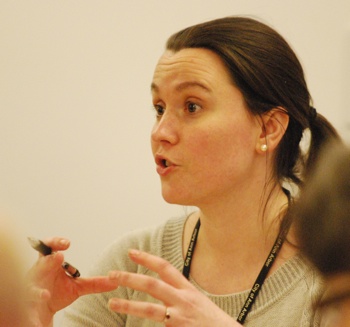
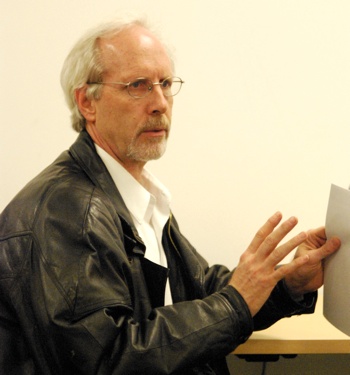
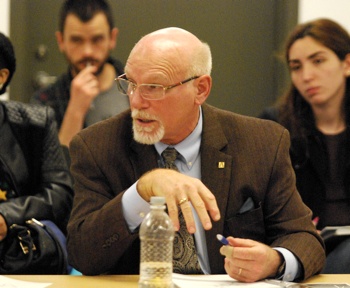
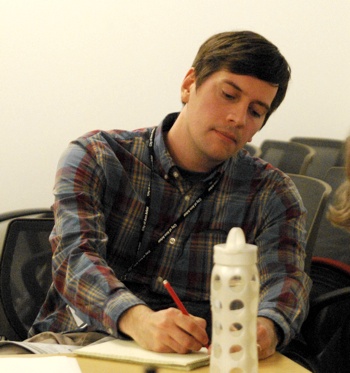
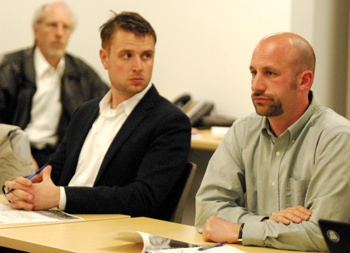

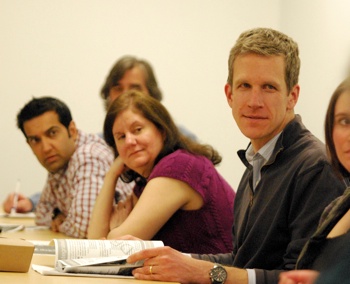
Regarding the suggestion of regional planning for parks: this has been done. There was a determined drive for regional planning while the County still had a planning department. There were numerous meetings of the Washtenaw Metro Alliance (communities of the SE Washtenaw County “metro” region) and an open space plan was formulated but it was never used by the individual municipalities. I don’t know that the Ann Arbor Parks Commission or Greenbelt Advisory Commission even ever discussed it or attempted to address any of the proposed initiatives.
I have recounted part of the history of regional planning in Washtenaw County in my post [link]. Briefly, after much effort and talk, the effort foundered and the county planning department was disbanded. I make the case in my post and some others that the governmental structure in Michigan is an almost insurmountable barrier to successful regional initiatives.
It seems that council and mayoral candidates perennially bring up “regional solutions” to various problems, but the barriers remain and most of what will happen is a great deal of conversation.
If you would like to see a different case study of regional cooperation, follow the current issues surrounding the Detroit Water and Sewerage services. Even the rationalization of such an essential service is running up against many barriers.
Evidently both the city of Ann Arbor and the city of Ypsilanti adopted the county “Green Places: Open Spaces – A Plan for Coordinated Parkland and Open Space” in 2008. There is no indication that any of the townships adopted the plan. Page on the county website: [link]
Regarding the Detroit water system regionalization effort: here is a good recent article on its failure. [link]